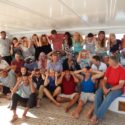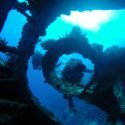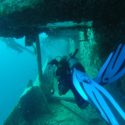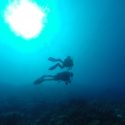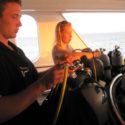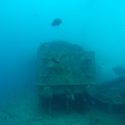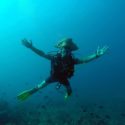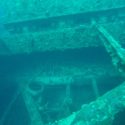Members of East Midlands Universities Air Squadron (EMUAS), supported by members of the RAFC Cranwell Sub-Aqua Club (CSAC), deployed to Hurghada, Egypt, to conduct a diving expedition aboard a dedicated dive vessel during the period 27 Jun – 5 Jul 14.
The aim of this expedition was for all EMUAS students to gain a recognised British Sub Aqua Club (BSAC) Diving qualification and to develop their personal leadership and management qualities. In addition 2 members of EMUAS were to act as instructors under supervision having completed the Instructor Foundation Course just prior to the expedition.
The diving location was chosen such that all personnel encountered circumstances which, to some degree, prepared them for the challenges of contemporary operations or future careers in the Armed Services. As such the aims were wider than pure Sub-Aqua training and also focused on managing activities in unfamiliar environments in foreign lands.
Students from EMUAS carried out the majority of the organisational tasks, under supervision, for both the pre-deployment and deployed portions of the expedition. The expedition was designed to maximise every possible sub-aqua diving opportunity and to be both physically and mentally challenging whist remaining under controlled and closely supervised conditions. The expedition developed the personal qualities of confidence, mental toughness, self reliance, endurance and team ethos through the medium of sub-aqua diving.
EMUAS expedition members were selected from all available year-groups within EMUAS and support was provided by 4 members of CSAC. The final expedition composition was of 20 trainees (11 novices and 9 progressing to their next qualification (including the 2 EMUAS Instructors under supervision)) and 4 instructors. Prior to the expedition all trainees completed theory and pool training at the CSAC and in order to prepare the trainees for the Red Sea, 3 weekend diving expeds to Gildenburg Lake near Peterborough were conducted mid-May to mid-Jun.
The expedition itinerary commenced with training for divers to achieve their next diving qualification and then to move on to expand experience and to undertake syllabus experience dives for all. The initial training took place during the first 2 days and was completed as planned although the locations chosen were not those originally planned due to weather, highlighting the flexibility advantages of the dedicated dive vessel.
Once training was complete the boat moved out to Gabul Island and Abu Nu’has to make the most of the excellent weather; the forecast was that by day 4 Northerly winds would build and exposed sites would not be fit to dive. Thus the newly qualified divers had 3 days of world class wreck diving immediately after qualifying. The winds did indeed build but not until the penultimate day of the exped which allowed every planned diving location to be dived; a great achievement indeed considering the experience of the Ocean Divers.
Specific activities by day were as follows:
Day 1
Travel to Egypt began with an 0600 departure from RAFC Cranwell.
Day 2
The first dive of the trip was a very basic dive on the reef at Sha’ab el Erg. This site was chosen to for its simple nature and ease of access. It was perfect for the students to learn how the diving would work, how to use the dive deck and how the organization of the waves would be managed. The second dive was undertaken in the same location and concentrated on progressing novices towards the Ocean Diver qualification. For the third and final dive of the day El Fanadir was selected. This was another reef dive where trainees could continue to become familiar with the underwater conditions. This was a slightly more challenging reef with more to see and a requirement for better buoyancy skills.
Day 3
The first dive of the day was a 0500 start for the group at small Gubal Island on the wreck of a small barge. The students working towards their Ocean Diver qualification were leading dives which meant planning the dives thoroughly and taking responsibility for the dive. For the newly qualified Ocean Divers this built their confidence as they were now able to dive without an instructor being directly involved.
The second dive was on the wreck of the Ulysses. Diving this first wreck demonstrated the requirement for divers to focus on keeping their buoyancy under close control so as to not kick the wreck and damage either themselves or the coral, this dive also introduced many of the group to the use of a RHIB for transport to and from the dive site.
The third dive was on the wreck of the Chrisoula K. This was an impressive wreck, and was situated at much deeper depths than previously experienced on the trip. Care had to be taken by all not to break depth limits.
The fourth and final dive of the day was also at Abu Nuhas and half the trainees had their first ever night dive on the wall here. This was yet another new environment which pushed individuals comfort boundaries.
Day 4
The group rose early again for two more dives on the wrecks here. The first dive was on the wreck of the Carnatic, a steam and sail vessel lost in the late 19th century. With the wind building there was a significant surface swell which meant that entry into the RHIBs after the dive was physically challenging and required good teamwork.
The final wreck at Abu Nuhas was that of the Ghiannis D. This was another imposing wreck and again depth limits had to be closely observed. The use of RHIBs required the use of Delayed Surface Marker Bouys and timekeeping to be able to keep the waves of divers running smoothly.
The boat then sailed into the strait of Hormous to the site of the wreck of the SS Thistlegorm. Thistlegorm is a wreck from WWII and was sunk with her full wartime cargo still on board. The wreck has not been salvaged and can be considered to be a time capsule of a WW2 freighter. Thistlegorm is a very popular wreck and was very busy with 8 other dive boats on the wreck. This necessitated good navigational skills, thorough pre-briefing and careful timing of the dives to ensure that overcrowding on the wreck was avoided. With a plethora of mooring lines attached to the wreck choosing the correct line to ascend on was paramount less one ended up on the wrong boat. The more advanced divers, in their buddy pairs were able to penetrate the holds of the wreck and again good briefing and preparation was essential. This was again pushing student’s personal boundaries.
The fourth dive of the day was another night dive on the wreck, all thoroughly enjoy the wreck by torchlight.
Day 5
Having had 3 very early starts and long diving days, diving commenced slightly later on day 5. Sports divers were able to get further depth progression in the heavily damaged rear holds of the Thistlegorm whilst the ocean divers enjoyed the upper forward holds with their selection of vehicles and wartime goods.
The boat then re-located to Small Gubal Island for a drift dive on the outer wall of the Island; this was a first drift dive for many of the group. After the dive a rescue training exercise was set up for one of the group who was working towards his Dive Leader qualification. This short scenario was to test his handling of an incident; it also gave a few of the sports divers the chance to practice their own life support skills and provided them with a first look at the demands of managing diving. Finally another night dive was undertaken on the barge which highlighted the need for dive discipline as specific time restrictions had been set for the dive.
Day 6
The first dive of the day was on the wreck of the Rosalie Möller. This wartime wreck lies at a significant depth with the deck being at 35 meters. Only the sports divers could go on the wreck and the opportunity was taken to complete depth progressions for all that dived. At this kind of depth both air and time until decompression stops severely curtail the time which can be spent on the bottom, meaning that the divers needed to meticulously plan and execute their dive; the dive challenged the skills of the new sports divers.
The second dive was a shallower dive, with ocean-ocean and sports-sports pairs diving together giving scope for the pairs to assume responsibility and plan their dives.
The third dive was from RHIBs and was on a reef. The final night dive again was focusing on the divers going off in pairs without direct instructor assistance. This forced the divers to make sure to navigate and monitor time and depth correctly. The reef was quite featureless and it was dark which demanded that the divers accurately navigated the site and that they managed their return to the boat on time. All dives were completed on time and without breaking any of the pre-set limitations.
Day 7
The final day began with a transit near to Hurghada and a wall dive on a popular reef. After a week of seeing very few other divers underwater this crowded site was slightly disappointing.
The final dive was undertaken on the wreck of a minesweeper located just outside of the harbour in Hurgharda. The El Miniya was an Egyptian minesweeper sunk during a raid by Israeli F-4 Phantoms. This was quite a deep wreck so the all divers had to pay close attention to their depth, decompression times and air. Again all divers stuck to their dive plan and stayed within all limits; well done!
Outcomes
In total 439 dives and 266 hrs 07 mins underwater time was completed on the expedition, 10 divers qualified as Ocean Divers, 5 qualified as Sports Divers, 1 qualified as a Dive Leader, 1 progressed towards Sports Diver and 3 progressed towards Dive Leader; finally one diver crossed over from PADI Open Water diver to BSAC Ocean Diver. In addition a considerable number of additional experience dives took place after qualification which included all Ocean Divers being trained in the use of the DSMB.
Ex CLEARWATER DOWN 14 proved to be a challenging and rewarding expedition and can be considered to be a great success. All expedition aims were met and all novice divers achieved their Ocean Diver qualification, whilst already qualified divers progressed towards their next level of certification. In addition a wide variety of diving experience was gained allowing expedition members to experience diving beyond the training environment; without doubt the wreck diving served to inspire the students to continue to dive whenever the opportunity arises.

